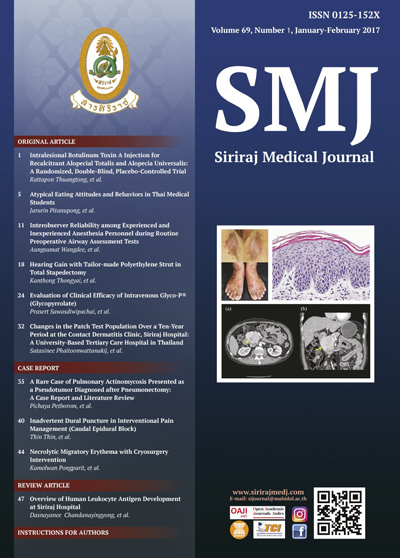Interobserver Reliability among Experienced and Inexperienced Anesthesia Personnel during Routine Preoperative Airway Assessment Tests
Keywords:
Interobserver reliability, preoperative airway assessment, registered nurse anesthetist studentsAbstract
Objective: The authors aimed to determine the interobserver reliability during routine preoperative airway assessments by experienced and inexperienced assessors. For the current, Thai registered-nurse-anesthetist-student training curriculum for preoperative airway assessment classes, the accuracy of airway evaluations performed by those trainees has not yet been evaluated.
Methods: An experienced anesthesiologist, a resident, a nurse anesthetist and thirty-one registered nurse anesthetist students were enrolled in a prospective observational study to assess eight obese and ten lean volunteers using seven airway assessment methods at the beginning of an academic year. The sternomental distance (SMD), the thyromental distance (TMD), the hyomental distance (HMD), the inter-incisor gap (IIG), malformation of the teeth, the Mallampati classification (MPT) and the range of neck movement (RNM) were assessed. Interobserver reliability was determined using intraclass correlation coefficient (ICC) and kappa coefficient (K).
Results: Higher strengths of interobserver agreements; and good to very good agreements were found among the two, more experienced assessors, namely, the resident and the nurse anesthetist. When seven airway assessment methods were evaluated by registered nurse anesthetist students, the interobserver agreements ranged from poor to moderate. For the subgroup analysis of lean and obese volunteers, higher reliabilities of airway assessments were found for the lean volunteers.
Conclusion: The accuracies of the airway assessments performed by the registered nurse anesthetist students were lower than those of the more-experienced groups. Thus, there is some room for improvement in the current nurse-anesthetist curriculum.
Downloads
Published
How to Cite
Issue
Section
License
Authors who publish with this journal agree to the following conditions:
Copyright Transfer
In submitting a manuscript, the authors acknowledge that the work will become the copyrighted property of Siriraj Medical Journal upon publication.
License
Articles are licensed under a Creative Commons Attribution-NonCommercial-NoDerivatives 4.0 International License (CC BY-NC-ND 4.0). This license allows for the sharing of the work for non-commercial purposes with proper attribution to the authors and the journal. However, it does not permit modifications or the creation of derivative works.
Sharing and Access
Authors are encouraged to share their article on their personal or institutional websites and through other non-commercial platforms. Doing so can increase readership and citations.











